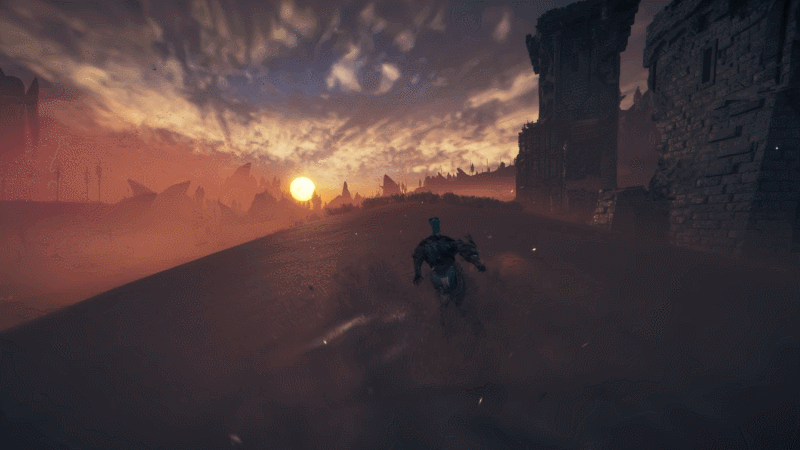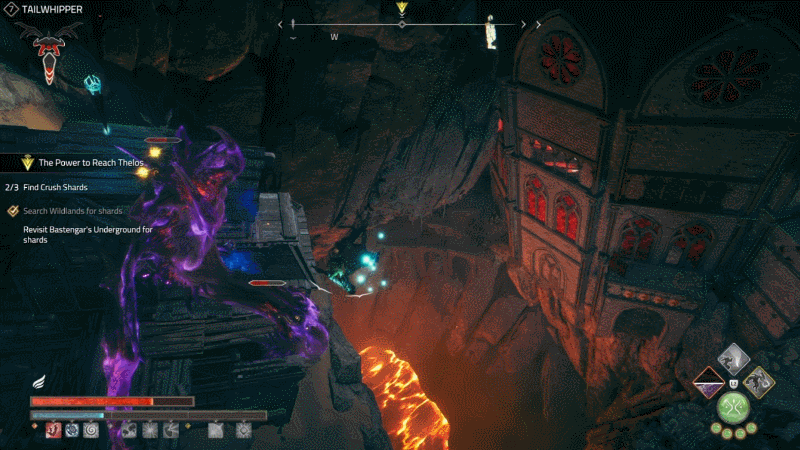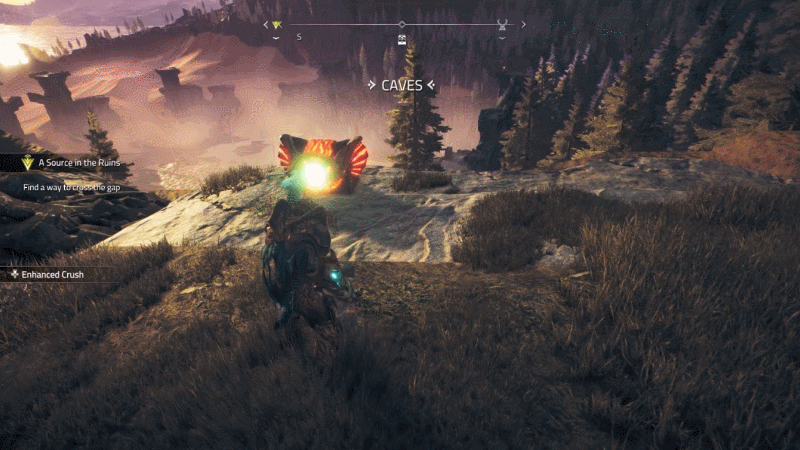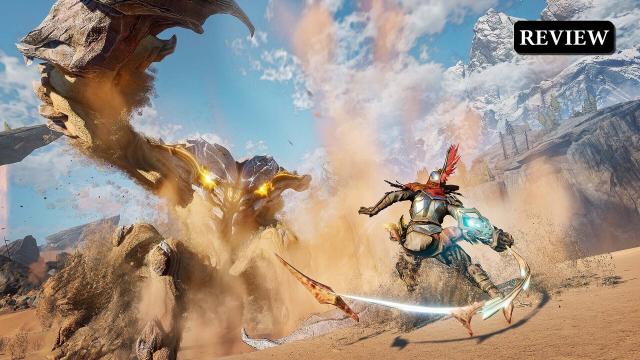Atlas Fallen is a classic jack-of-all-trades, master of none. It’s an open-world action RPG Metroidvania platformer with co-op that tries to do so many things it rarely does any of them well. That doesn’t make it a bad game, just, more often than not, a forgettable one. I had some fun surfing its sandy dunes and pummeling giant monsters with equally giant magic knives and hammers, but the novelty wore off long before the game had ended, leaving me ultimately disappointed as I wandered the apocalyptic ruins of its world in search of a reason to keep going.
Deck13’s previous two games, The Surge 1 and 2, were grim Souls-likes that revolved around sawing off enemy limbs in a brutal near-future dystopia. They were suffused with a distinctive mood of anti-corporate technophobia and buoyed by a clear focus on challenging combat and environmental mazes that strung you along from one encounter to the next. Atlas Fallen is very different in almost every way, trading the punishing fights and bonfire structure of Dark Souls for open-world checklists and arcadey arena brawls. Unfortunately, none of it quite comes together, resulting in an uneven mess of ideas that get boring pretty fast.
Out August 10 on PlayStation 5, Xbox, and PC, you play as an “Unnamed,” a peasant on the lowest rung of labourers in a desolate wasteland who happens to discover a long-lost gauntlet that hides considerable power as well as a glowing blue spirit with amnesia called Nyall. Together you two trawl wide swaths of hazy, dying lands filled with monsters called Wraiths in search of missing bits of the Gauntlet that can be used to restore its power, recovering Nyall’s memories along the way and eventually setting in motion a rebellion against the autocratic control of a sun god named Thelos.
The setup’s a whole lot, in a very Video Game kind of way, especially for a game that’s fundamentally about running and hitting things. Characters will frequently be saying stuff like, “I’m working with the Knights of Bastengar to overthrow the Queen and for that I need to derail the Essence Blessing.” That’s fine for a fantasy world steeped in hundreds of years of mythology, much of which can be unearthed in interesting lore capsules, but weak characters and dreary, vacant landscapes left me struggling to get invested in these aspects of the story relative to the amount of time the game spends on them.
Atlas Fallen’s narrative ambitions never quite coalesce with the free-form exploration side of its action-RPG formula, and it rarely left me wishing a conversation would last longer, especially with English voice acting that sounded so wooden and detached. There are NPCs to chat with and tons of side quests to complete. Attempts were made. Instead, I mostly just wanted to get back to dashing around the map, beating up monsters, and opening treasure chests.
Sprinting is really fast in Atlas Fallen, helping you cover the vast distances between points of interest quickly. On dirt and stone you run, while on sand you slide forward like you’re ice skating. The Gauntlet adds to your traversal, eventually giving you a double-jump and up to three mid-air dashes as you power it up. It can also be used to raise certain pieces of ruins from beneath the sand, giving you a higher vantage point from which to scale a building or jump across a large chasm.

Everything you can levitate out of the ground is marked with a turquoise aura, and while the action itself is satisfying to perform, the possibilities are actually quite narrow, leading to simple puzzles and platforming sections that rarely require you to think more deeply about your surroundings or any secrets that might be hidden in them. At its core, Atlas Fallen is a map game where every section of the world is littered with points of interest to complete and collectibles to acquire. The lizard part of my brain enjoyed knocking each new icon off my to-do list, watching the counters for my various resources and currencies tick up, but exploration soon became rote. There was rarely ever the feeling I had stumbled upon something I wasn’t expecting to find.
Anvils scattered around the map can be activated for fast-travel points as well as rest stops for restoring health, improving armour, and upgrading abilities. Finding each area’s vantage point will reveal all of the nearby secrets so you can mark them on the map. There are also rocks that, when you raise them from the ground, point like beacons to another one nearby. Once you find them all they’ll lead you to a treasure chest, a power shard for your gauntlet, or something else useful. Statues of Thelos, the malevolent sun god that people worship, can be shattered as an onscreen pop-up tells you how many more are still on the list. It was fine at first thanks to the ease of movement and the moment-to-moment controls. After reaching the second of three maps, however, I was already burned out.
Atlas Fallen’s combat is better. Your gauntlet lets you mould matter into three different weapons that get more massive as you build up a blue “momentum” meter by killing enemies or parrying them. The more meters you have, the more damage you deal and the more damage you receive. You can also equip what are called “Essence stones.” Some offer especially abilities on a cooldown, while others bestow you with stat buffs or trade-offs like gaining more momentum at the expense of constantly losing health.

The stones are only activated in battle once your momentum meter hits certain intervals. The more successful you are at dishing out pain, the stronger and deadlier you become in a rewarding cycle that makes it easy and entertaining to snowball during fights. When it’s at its best, Atlas Fallen’s combat has you lassoing an enemy, pulling yourself towards it, unleashing an aerial combo, then dashing to the next one, parrying an attack, countering, and zipping back to the other side of the fight without breaking a sweat.
The momentum meter culminates in a special automated Shatter attack that’s bigger and deals more damage the more full it is, adding another wrinkle to the flow of combat, especially since various enemy attacks will constantly drain your momentum. The result is a surprisingly engaging set of decisions to make while swinging giant hammers and chains. There’s a bunch of different Essence stones you can collect and craft depending on how you want to approach combat, adding a good amount of customization without overloading you with numbers and build crafting. Armour sets you collect and upgrade, as well as Icons that heal you with unique effects, add to the adaptability of your arsenal.
I just wish Atlas Fallen provided a better set of monsters to use it on. You’ll be fighting the same four smaller ground and aerial Wraiths the entire game, while larger mini-bosses begin to populate the rest of the map as you beat each one over the course of the main story. It starts to feel repetitive pretty quick, especially since you spend so much time backtracking through the same areas.

Larger Wraiths have multiple body parts you can target, and killing the extra ones first will grant you more resources at the end of the battle. The third-person camera and aiming in the game can be so messy, however, and the attack radius of your weapons is so broad, that this system felt like more trouble than it was worth. Even worse, it sometimes led to me swinging away only to miss the enemy’s hit box completely because I’d already killed that limb. There’s nothing worse than beating empty sand as a three-story demonic entity disappears offscreen in the chaos.
I’d love to see the full promise of Atlas Fallen’s combat verticality unleashed on a Shadow of the Colossus-sized fiend. Instead, there’s often too much going on to make its larger battles feel like worthy canvases on which to express its possibilities. Boss fights are always accompanied by waves of smaller Wraiths which, when combined with lots of area-of-effect explosions, lasers, and other attacks untethered to the laws of physics, usually make encounters feel more confusing and disorganized rather than tense and dramatic. The final boss fight was especially anticlimactic.
In my favourite moments with Atlas Fallen, its sandbox traversal reminded me of the joy of running around Sucker Punch’s first Infamous, and its hack-and-slash combat channelled the satisfying chunkiness of Vigil Games’ first Darksiders, two games that turned grab bags of existing ideas and mechanics into new franchises that felt distinct and worthwhile. Gaming is more inundated than ever with remakes and sequels, so it’s refreshing and inspiring when a studio takes on the challenge of aiming big with something new, especially without the backing of one of the major console makers. It’s a shame, then, that Deck13’s latest can’t get off the ground. Like the sandy ruins filling its world, the best parts of Atlas Fallen feel buried beneath the same open-world junk you’ve already done in a bunch of other games.

Leave a Reply